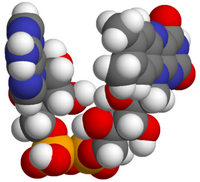
Photo from wikipedia
Abstract The conformation of glutathione is of great significance for its biological function. In this study, the absorption spectra of reduced (GSH) and oxidized (GSSG) glutathione in the frequency range… Click to show full abstract
Abstract The conformation of glutathione is of great significance for its biological function. In this study, the absorption spectra of reduced (GSH) and oxidized (GSSG) glutathione in the frequency range of 0.5–12.0 THz were obtained by air plasma terahertz time-domain spectroscopy (THz-TDS). The results demonstrated that GSH had rich characteristic absorption peaks in the THz region, while GSSG presented a monotonous absorption spectrum without obvious peaks. Combined with powder X-ray diffraction (PXRD), GSH had a certain crystal structure and GSSG was amorphous, suggesting that the THz spectroscopy was sensitive to the molecular structure and crystal form. The density functional theory (DFT) calculation based on the GSH crystal structure was performed to simulate the THz absorption spectrum and analyze the vibrational property. The result showed that GSH molecule could form rich inter- and intramolecular hydrogen bonds which helped to constrain flexible peptide. Lattice vibrations and hydrogen bonds of GSH could effectively resonate with THz waves. The different THz absorption peaks of GSH corresponded to different collective or local molecular vibrations which were closely related to the hydrogen bonding interactions. The study may help to deepen the understanding of GSH molecular conformation and weak interactions.
Journal Title: Chinese Journal of Analytical Chemistry
Year Published: 2020
Link to full text (if available)
Share on Social Media: Sign Up to like & get
recommendations!